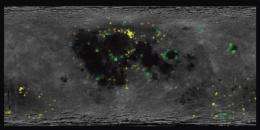October 31, 2012 report
Researchers find evidence that moon's Procellarum basin formed by asteroid strike

(Phys.org)—Researchers at Japan's National Institute of Advanced Industrial Science and Technology propose in a paper published in the journal Nature Geoscience, that a strike by a large asteroid approximately 3.9 billion years ago, explains the geological characteristics of the moon's Oceanus Procellarum (Ocean of Storms) basin.
Scientists have known for more than half a century that the surface of the near side of the moon – the side closest to the Earth – differs significantly in appearance from the far side. Explanations for the differences have ranged from gravity effects from Earth to collisions by asteroids. One of the most profound differences is the Procellarum basin, a dark region on the near side surface that has caused some to name it the "Man in the Moon." Now new evidence by a team in Japan indicates that the 1,800 mile wide flattened area, may indeed have come about as the result of a collision with a large asteroid.
To come to this conclusion, the team has been analyzing mineral distribution on the surface of the moon using data obtained from the Japanese moon orbiter Kaguya/Selene. Using light reflection data from 70 million locations across the surface, they have found deposits of the low-calcium mineral pyroxene surrounding the Procellarum basin. Prior research by others has shown pyroxene can be linked to the melting of material brought up from the lunar mantle. In this case, the team suggests the mantel material was brought up from below and melted by the energy released as the moon was struck by an asteroid approximately 300 kilometers in diameter. In its aftermath, they suggest, a molten sea several hundred kilometers deep was formed in the crater that resulted, which cooled over time, eventually leading to the dark appearance of the basin we see today. Such a collision they claim, would have completely obliterated the crust at the impact site.
The team adds that subsequent smaller asteroid strikes would have blurred the edges of the impact zone making it difficult to discern the actual outline of the initial strike, leading to confusion over just how large of an area was affected by the large asteroid. The ring of pyroxene, they say, helps more clearly define its edges.
More information: Compositional evidence for an impact origin of the Moon's Procellarum basin, Nature Geoscience (2012) doi:10.1038/ngeo1614
Abstract
The asymmetry between the nearside and farside of the Moon is evident in the distribution of mare basalt, crustal thickness and concentrations of radioactive elements, but its origin remains controversial. According to one attractive scenario, a gigantic impact early in the Moon's history produced the observed dichotomy; the putative 3,000-km-diameter Procellarum basin has been suggested to be a relic of this ancient impact. Low-calcium pyroxene can be formed during an impact by melting a mixture of crust and mantle materials or by excavating differentiated cumulates from the lunar magma ocean. Therefore, the association of low-calcium pyroxene with a lunar basin could indicate an impact origin. Here we use spectral mapping data from KAGUYA/SELENE to show that low-calcium pyroxene is concentrated around two established impact structures, the South Pole–Aitken and Imbrium basins. In addition, we detect a high concentration of low-calcium pyroxene at Procellarum, which supports an impact origin of the ancient basin. We propose that, in forming the largest known basin on the Moon, the impact excavated the nearside's primary feldspathic crust, which derived from the lunar magma ocean. A secondary feldspathic crust would have later recrystallized from the sea of impact melt, leading to two distinct sides of the Moon.
Journal information: Nature Geoscience
© 2012 Phys.org




















